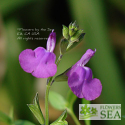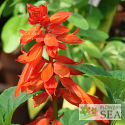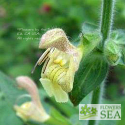(Blau Hügel Meadow Sage) When in bloom, petite Salvia nemorosa 'Blau Hügel' more than doubles in height. In English, the varietal name means "Blue Hill." Its tall, spike-like racemes of violet-blue flowers are so dense and compact that this woodland sage is sometimes called "Blue Mound."
This hardy perennial sage is a longtime favorite that German nurseryman Ernst Pagels introduced in the late 1950s. Pagels was a major influence on the naturalistic style of Dutch garden designer Piet Oudolf. The Remembrance Gardens of New York's Battery Park, designed by Oudolf, contain Blau Hügel Sage.
Blau Hügel is part of the European Meadow Sage group, which is comprised of four main species -- S. nemorosa, S. pratensis, S. x sylvestris and S. x superba.
European Meadow Sages are adaptable from full sun to partial shade. They are known for excellent cold tolerance, adaptability from full sun to partial shade and appreciation of lots of moisture as long as soil drainage is good. Unlike some of its relatives, this variety also tolerates heat.
Due to a randy habit of cross hybridizing, confusion occurs in scientific naming of Meadow Sages. For example, S. nemorosa 'Blau Hügel' sometimes is referred to as a type of S. x sylvestris.
Whatever you call it, this long-blooming sage is a blue plate special for butterflies and honeybees. Fortunately, similar to so many Salvias, this plant doesn't call deer to dinner.





